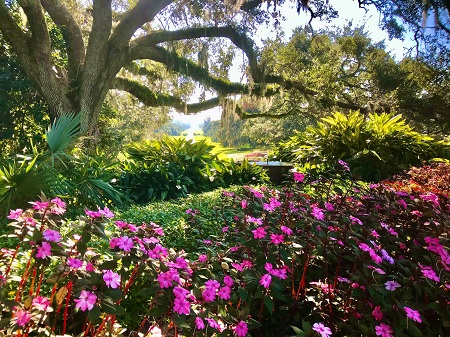A Salt Island on Coastal Louisiana
We invite you to the charming and mysterious Jefferson Island.
Near the southernmost part of Louisiana's delta country lie a series of five wooded "islands," which rise up above the grassy marshlands and prairies that surround them. From 50 to 100 feet above sea level, these areas of high ground are sitting on top of mammoth, immovable columns of salt, which hold them up above the surrounding countryside.
These monoliths of salt are two to three miles wide and five miles or more in depth. Jefferson Island is one of the five islands. A mysterious place, the island is haunted by the legend that Jean Lafitte, the pirate, buried his treasures under the giant live oaks that would later shelter a home and garden.

Rip's Rookery
The vista leading to Rip Van Winkle Gardens is fringed with Rip Van Winkle Road, a one and a half mile avenue of live oaks, sentinels along the roadside.
On both sides of the road, ponds surrounded by cypress trees offer two places of residence for the egrets and spoonbills that cross the road daily, sauntering back and forth between ponds, sometimes accompanied by a thick-billed pelican that has made the island his home. Visitors can see the birds at Rip’s Rookery, located at the corner of Rip Van Winkle and Jefferson Island Roads. The nesting and rearing period is from March through June or July, depending on the weather.

The 1980 Drilling Disaster
On November 20, 1980 a drilling rig pierced one of the giant caverns of the Diamond Crystal Salt Mine, flooding the entire mine. A vortex swallowed the lake, 65 acres of native wood land, a welcome center, a glass conservatory and a new home just built on the lake.
The property now belongs to Mike and Louise Richard who offer tours of the Victorian Jefferson Mansion and its exotic gardens seven days a week. Café Jefferson is open daily for lunch with a full menu and a stunning view of Lake Peigneur and the gardens. There are three beautiful bed and breakfast cottages to call home for a peaceful get-away.









